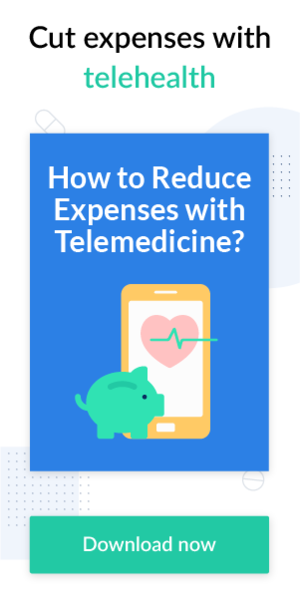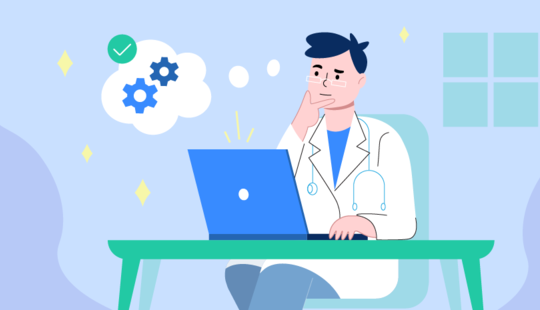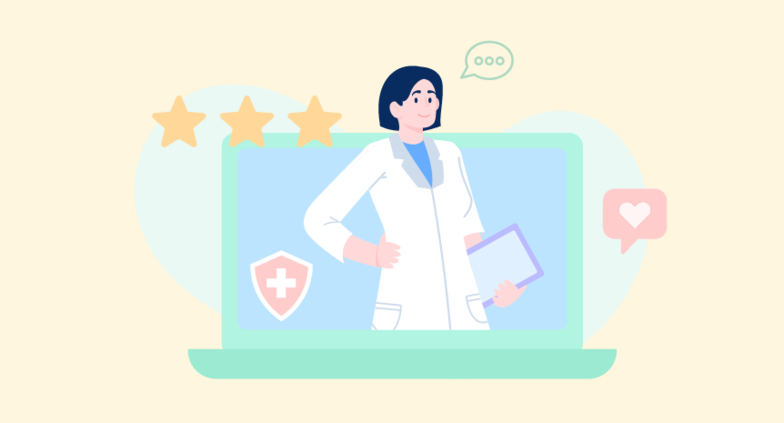In the healthcare industry, the way you provide services is crucial. It defines the value, efficiency, and quality of patient treatment. Today, telemedicine offers three main options for healthcare service delivery:
- Real-time interactive telemedicine
- Store-and-forward telemedicine (asynchronous video)
- Remote patient monitoring (telemonitoring)
Each telemedicine type has advantages. When used correctly, both healthcare providers and their clients can benefit greatly from telemedicine through increased patient engagement, faster access to more accurate health data, medical access for people without health insurance, and much more.
In today’s article, we’ll reveal the essential advantages of the three telemedicine types, explain the concepts behind each of them, and share what kind of healthcare specialists they fit. Let’s get started!
Types of telemedicine
To cover a wide range of health issues, telemedicine providers offer real-time interactive telemedicine, remote patient monitoring, and store-and-forward telemedicine. Each type of telemedicine possesses its own characteristics that fit a specific medical workflow. That said, there are some overarching benefits, like enhanced patient engagement and reduced healthcare spending. Now, it’s time to learn about the three types of telemedicine and who they best fit.
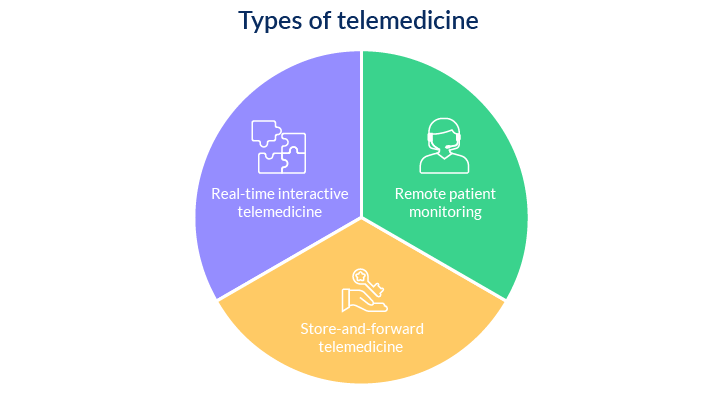
Real-time interactive telemedicine
Real-time interactive telemedicine is provided via secured videoconferencing, messaging apps, or other online communication channels. It can even be provided via a phone call. The gist is that real-time telemedicine replaces traditional in-person doctor’s office visits.
This type of telemedicine is widely used by primary care physicians and psychiatrists. It provides timely care, especially in emergencies. Real-time interactive telemedicine is great for follow-up visits and medication oversight.
It’s important to keep in mind that all medical communications have to be executed through Healthcare Insurance Portability and Accountability Act (HIPAA) compliant telemedicine platforms. Using popular messengers is illegal and unethical in terms of data storage security.
Launch your telemedicine practice by taking the first simple steps with our ExpertBox guide, and let online patients reach out to you.
Real-time interactive telemedicine benefits
Live consultations require less effort from patients to get the same quality of service as with in-person doctor visits. The main advantages of real-time interactive telemedicine are:
- Reduced wait times. Patients no longer have to stay in waiting rooms to see a doctor. Physicians can provide immediate diagnoses or treatments by connecting instantly to a scheduled meeting with a patient. It’s as simple as that.
- Easy and accessible healthcare. There is no need to visit facilities. For patients from rural areas and underserved locations, as well as for patients with disabilities, real-time interactive telemedicine is especially helpful.
- A fully booked calendar. As a specialist, with real-time interactive telemedicine, you can book appointments for patients across your licensed region. You are not confined to your local area. Some telemedicine platforms also support booking pages that practitioners can use to manage their calendars and schedule their working hours.
- Enhanced patient engagement. Because interactive consultations include live dialogues, patients and physicians can establish an emotional connection. This increases patient loyalty.
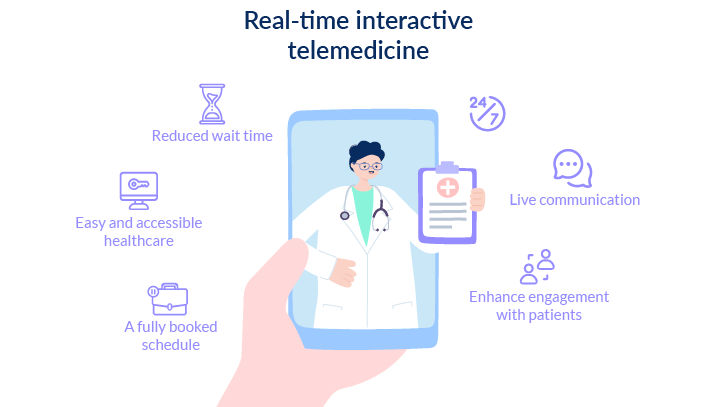
All the benefits mentioned above drastically simplify the delivery of healthcare services. If you want to deliver services in real time, you need software that meets your requirements. See how easy it is to streamline the booking process and organize chats and video calls with your patients using ExpertBox.
Real-time interactive telemedicine applications
Videoconferencing helps practitioners of different specialties carry out their services. A live interactive video format is efficient for counseling and cases that require oversight.
- Telepsychiatry. Videoconferencing works well for psychiatry consultations because they are mostly focused on dialogue between the psychiatrist and a patient. Telepsychiatry can be extremely helpful when a patient needs immediate therapy.
- Telenursing. Nurse practitioners can use real-time telemedicine to oversee a patient’s health condition. Nurses can also see if a patient is taking medications as prescribed.
- Telepharmacy. Pharmacists can provide patients with counseling and drug therapy monitoring and can deliver medical prescriptions electronically when needed.
- Telerehabilitation. A patient can do physical rehabilitation exercises at home while a doctor evaluates the performance through video.
- Teleneuropsychology. It is a form of telemedicine that involves providing neuropsychological consultation and assessment over the phone to those with or suspected of having cognitive disorders.
Store-and-forward telemedicine (asynchronous video)
Store-and-forward telemedicine is also called asynchronous telemedicine. This telemedicine type is based on the transmission of health data between doctors and patients by electronic means. This information can be laboratory reports, images (MRI scans and X-rays), sound and video studies, or anything else. To ensure patient confidentiality, health data must be transmitted via a secured communication system.
Store-and-forward telemedicine is focused on the secure storage and forwarding of medical records for treatment purposes. This telemedicine approach dramatically increases operational efficiency. When specialists from different locations work with a patient together, they can communicate immediately through electronic channels. Also, store-and-forward principles are followed when healthcare organizations implement their internal electronic health record (EHR) systems.

The benefits of store-and-forward telemedicine
Using store-and-forward telemedicine significantly increases the quality of healthcare services and the patient experience. With a faster workflow, patients get better results more quickly.
- Reduced wait times for diagnosis and treatment. Patients don’t need to schedule and wait for an additional specialist visit to get the results of their examination. They can receive their results electronically right from their computer through a quick, simple, and convenient process.
- Availability of second opinions. While working on a patient diagnosis together, specialists can exchange information with each other on their own time. There is no need for general practitioners, specialists , and patients to meet at the same time. Once the medical records are sent to all involved parties, each person can process the records at a convenient time.
- Expense reimbursement. Medicaid and Medicare have a wide coverage area, and a lot of states provide patients with health insurance. For some vulnerable populations, government funding is the only way to get medical services.
- Improved evidence-based care. Healthcare providers can collect patient information, analyze data, and make an informed diagnosis with store-and-forward telemedicine. It becomes easy to store a patient’s health records and access them anytime.
Learn more about the ways telemwdicine can benefit your meducal practice! Check the article on telenedicine benefits to explore how it can boost the patient outcomes!
Store-and-forward applications
Healthcare services are based on health data and medical records. Thus, when it’s possible to speed up the data exchange process, a wide range of specialists will take advantage of it.
- Teleradiology. A radiologist or physician can receive electronic images of X-rays taken at a remote location.
- Teledermatology. General practitioners can send a patient’s skin images and mole mapping to a dermatologist for diagnosis and treatment consultation.
- Teleophthalmology. Ophthalmologists can examine a patient’s eyes remotely, using videoconferencing, or can study patient images (e.g. diabetic retinopathy).
- Telepathology. Physicians use store-and-forward telemedicine to transmit pathological data (cells and tissues) to colleagues in order to study the case together.
- Tele-endocrinology. Most endocrinology treatments are based on data collected during a patient's preliminary examination. Endocrinology specialists can pass data between each other to make a diagnosis.
- Stored interactive telemedicine. Stored Interactive telemedicine is a form of store and forward technology, similar to text messaging, which offers many of the advantages of real-time video interaction. For instance, ExpertBox allows patients to demonstrate their symptoms to doctors through video recordings.
Pro tip: Physicians in different medical spheres can stay ahead of the curve and enhance their patients’ experience with telemedicine solutions. Try ExpertBox online video meeting software to provide real value to your patients via secure virtual communication.
Remote patient monitoring (telemonitoring)
Remote patient monitoring (telemonitoring) is when a patient uses wearable devices (heart monitors, skin patches, smart shoes, or smartwatches) that collect vital data, pass it to applications on devices, and send it to a cloud-based telemedicine server. Healthcare providers oversee the data and analyze it. In some cases, the patient measures their vitals on their own rather than using an automatic tracker. For instance, a patient could use a special test kit to check their glucose level.
Typically, remote monitoring is used with patients who are dealing with chronic diseases like diabetes, asthma, or cardiovascular disease. It’s also a common practice to maintain distant monitoring of people who recently signed out of a hospital.

Benefits of remote patient monitoring
Telemonitoring allows physicians to oversee some of their patients remotely and asynchronously. This creates more time slots for physicians to work with other patients who need in-person consultations. Telemonitoring saves time and money and ensures high-quality care. More generally, it has the following benefits:
- Ongoing access to accurate health data. Since remote patient monitoring is based on collecting original health data via wearable devices, it allows practitioners to make informed data-driven decisions. Accurate vital records also facilitate an increased recovery rate.
- Optimized working hours. Physicians can receive health data without waiting for an in-person visit. Hence, they can process that data when it’s convenient for them. Physicians can schedule their working day efficiently according to their pace.
- Improved patient experience. Although the fact that most of the data is collected autonomously, there is some vital data that a patient should measure on their own. When physicians provide patients with tools for this purpose, patients can assist doctors and have a better healthcare experience.
- Cost savings. Instead of stationary treatment, which can be expensive, telemedicine allows people to stay in their homes under the remote supervision of healthcare providers.
Remote patient monitoring applications
Specialists can release their patients while continuing to monitor them. At this point, patients can get back to social life, and doctors can ensure patient safety.
- Telecardiologists. Cardiologists can examine the same data during telemedicine visits as they would during traditional visits. The only difference is that the data is received remotely from devices, not in person.
- Telecaregivers. These specialists can monitor dementia patients who have an increased risk of falls. They can track data collected from smart canes, such as data on weight-bearing while walking, linear acceleration, gait, and angular velocity. Algorithms can calculate the likelihood of falls in the moment so telecaregivers can contact patients or their relatives to make sure everything is alright.
- Fertility doctors. Telemonitoring is an alternative for in-person in-vitro fertilization procedures. Instead of running in-clinic examinations, fertility specialists can monitor health data remotely.
- General practitioners. Considering that remote patient monitoring is widely used for chronic disease supervision, general practitioners are some of the most common users of remote healthcare technologies.
Choosing a telemedicine platform
When choosing a telemedicine platform, make sure all your functional needs are covered. Check if the platform provides features that will simplify your activity and routine. For example, if you’re a radiologist, see if the telemedicine platform has an option for exchanging media files. This feature increases your operational efficiency by storing and forwarding patients' X-rays and other health data. If you’re a psychologist, you can use telemedicine solutions to keep all important information about your patients’ mental health easily accessible.
On top of that, some telemedicine platforms provide tools to manage your schedule and easily set patient appointments. Don’t forget to see if the software enables clients to reach out to you. Check out what payment options a platform offers, how quickly you can access an account, and if the platform provides technical and onboarding support.
As a telemedicine healthcare provider, you need a tech vendor that meets all legal standards for data storage and security. Finally, it’s nice to have a workspace that supports patient feedback so you can improve your services.

Improve your healthcare services by collecting meaningful feedback from your patients.
Summing up
Telemedicine has taken different approaches to be applicable to as many medical branches as possible. Various specialists and general practitioners are benefiting from telemedicine due to its accessibility, efficiency, and multifunctionality. Online treatment helps both physicians and patients save money and time. For practitioners who are eager to try remote healthcare, the key to success is finding a reliable telemedicine platform. While there are areas out of telemedicine's reach and some in-person visits that can’t be substituted with a virtual consultation, telemedicine can be an excellent option for physicians and patients.
If you need guidance to choose the right software for your private practice, you can book a FREE consultation with our Business Development Consultant and learn more about your telemedicine software options.
FAQ
-
Today, telemedicine includes:
- Real-time interactive telemedicine
- Store-and-forward telemedicine (asynchronous video)
- Remote patient monitoring (telemonitoring)
-
Real-time interactive telemedicine is when healthcare providers use secure videoconferencing, online chats, and messenger apps to consult, oversee, diagnose, and prescribe medications to patients.
-
Store-and-forward telemedicine is the collection, processing, and storage of medical records and health data in compliance with patient confidentiality requirements.
-
Remote patient monitoring (telemonitoring) is when a patient uses wearable devices (such as heart monitors, skin patches, smart shoes, or smartwatches) that collect vital data, pass it to applications on devices, and send it to a cloud-based telemedicine server. The health data on the cloud server is available for review by a doctor and the patient.
-
The benefits of real-time interactive telemedicine are:
- Reduced wait times for patients
- Easy and accessible healthcare
- A fully booked calendar for doctors
- Enhanced patient engagement
The benefits of store-and-forward telemedicine are:
- Reduced wait times for diagnosis and treatment
- Availability of second opinions
- Expense reimbursement
- Improved evidence-based care
The benefits of remote patient monitoring (telemonitoring) are:
- Ongoing access to accurate health data
- Optimized working hours
- Improved patient experience
- Reduced costs
-
Real-time interactive telemedicine works best for:
- Psychiatrists
- Nurses
- Pharmacists
- Rehabilitation specialists
Store-and-forward telemedicine works best for:
- Radiologists
- Dermatologists
- Ophthalmologists
- Pathologists
- Endocrinologists
Remote patient monitoring (telemonitoring) telemedicine works best for:
- Cardiologists
- Caregivers
- Fertility doctors
- General practitioners
-
There are three types of telemedicine that allow physicians get better outcomes:
- Real-time interactive telemedicine
- Store-and-forward telemedicine
- Remote patient monitoring
Sometimes resources also mention the fourth type in a classification, however, stored interactive telemedicine is generally included in store-and-forward type.
